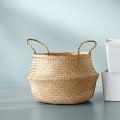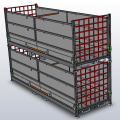Have you ever wondered how to securely lock a crate without it being easily broken into? It's a puzzle that many businesses, warehouses, and other organizations have been trying to solve for ages. Fortunately, the answer lies in understanding the various locking mechanisms available for crates. In this article, we'll unlock the mysteries of crate locking mechanisms and explore the customization options and additional features that can be employed to ensure maximum security. We'll cover everything from traditional locks and padlocks to advanced digital locks and more! So, let's get started and take a closer look at how to protect your valuable cargo with the right locking mechanism.
Different types of crate locking mechanisms:
Crate locking mechanisms come in many different shapes and sizes, depending on the level of security and convenience you need. Deadbolts are the most secure type of lock, as they require a key to open.Cam locks are also a secure option, as they are only accessible with a key or combination. Padlocks are a popular choice for crates, as they are easy to use and require no tools. Combination locks offer quick access but are less secure than other types of locks.
Advantages and disadvantages:
Each type of lock has its own set of advantages and disadvantages.Deadbolts are extremely secure but require a key to open, while combination locks offer quick access but are less secure. Cam locks offer a balance between security and convenience, as they can be opened with a key or a combination. Padlocks are easy to use and require no tools, but may not provide the highest level of security.
Choosing the right lock:
When choosing the right lock for your needs, there are several factors to consider. Security needs should be at the top of the list when selecting a lock.You should also consider ease of use, cost, and any additional features that may be needed. For example, if you need to access the crate frequently, then a combination lock might be a better choice than a deadbolt.
Maintenance:
Once you have selected the right lock for your needs, it is important to keep it properly maintained. This includes regular cleaning and lubrication of the locking mechanism to ensure it is in good working order. It is also important to check the lock periodically to make sure it is still functioning properly.Maintenance Tips
When it comes to maintaining your lock, there are some important considerations to keep in mind.First, make sure that the locking mechanism is always kept clean and free of debris. This will help to ensure that the lock operates properly and efficiently. Additionally, check the lock periodically for any signs of wear or damage, and replace it if necessary. It is also important to lubricate the lock regularly.
This will help to prevent rust and corrosion, and will ensure that the lock continues to operate smoothly. Finally, be sure to keep the key or combination safe and secure, as this will help to prevent unauthorized access to your valuable items.
Crate locking mechanisms
, lubrication, rust prevention, corrosion protection, key securityAdvantages and Disadvantages
When it comes to choosing the right locking mechanisms for your crates, it's important to consider both the advantages and the disadvantages. There are a variety of different types of locking mechanisms available, each with their own benefits and drawbacks. Here are some of the most common advantages and disadvantages of each type of locking mechanism.Keyed Locks: Keyed locks are one of the most secure locking mechanisms for crates. They offer a reliable layer of security, as only those with the right key can unlock them. However, this also means that they can be difficult to manage, as you'll need to keep track of multiple keys for multiple locks. Additionally, they can also be more expensive than other types of locking mechanisms.
Combination Locks:
Combination locks are a great option for those who don't want to worry about managing multiple keys.They offer a high level of security, as the combination must be entered correctly in order to open the lock. However, they can be difficult to reset if you forget the combination, and can also be more expensive than other types of locking mechanisms.
Electronic Locks:
Electronic locks are a great choice for those who want an extra layer of security. They offer the convenience of being able to open the lock with a code or key fob, as well as having the ability to track who has accessed the lock. However, they do require batteries and can be more expensive than other types of locking mechanisms.Padlocks:
Padlocks are one of the most affordable and versatile options for locking crates.They are easy to use and can be removed quickly when needed. However, they are not as secure as other types of locking mechanisms and can easily be cut or broken if not used properly.
Types of Locking Mechanisms
When it comes to securing valuable items, there are a variety of different locking mechanisms to choose from. These locking mechanisms can range from mechanical locks to electronic locks, and each has its own advantages and disadvantages. Here, we’ll explore the different types of locking mechanisms available, their pros and cons, and how to choose the best one for your needs.Mechanical LocksMechanical locks are some of the oldest and most reliable locking mechanisms available. They are typically made of metal and use a key to open them. These locks are usually very durable and can withstand a significant amount of force. The downside is that they can be difficult to operate, as they require a key to open.
Electronic LocksElectronic locks are becoming increasingly popular due to their convenience and ease of use. These locks can be operated via a code or card system, eliminating the need for a key. However, these types of locks can be more expensive than mechanical locks and require regular maintenance in order to keep them functioning properly.
Biometric Locks
Biometric locks are the most secure type of locking mechanism available.These locks use fingerprint or retinal scanning technology to unlock them, providing an additional layer of security. However, these types of locks can be very expensive and may not be suitable for all applications.
Combination Locks
Combination locks are another popular type of locking mechanism. These locks use a combination of numbers or symbols in order to open them, eliminating the need for a key or card.Combination locks are typically very durable and can withstand a significant amount of force, but they can be difficult to operate if the combination is forgotten or lost.
Magnetic Locks
Magnetic locks are a relatively new type of locking mechanism that utilizes magnets in order to secure items. These locks are typically very secure and can be opened with either a key or an electronic device, such as a smartphone or tablet. However, these types of locks can be expensive and require regular maintenance in order to keep them functioning properly.Choosing the Right Lock
Choosing the Right LockWhen selecting a locking mechanism for your crate, it is important to consider your specific needs.Different locking mechanisms offer different levels of security and convenience, so it is important to choose the one that best suits your needs. Here are some factors to consider when selecting a locking mechanism:1.The type of lock you need: Depending on what you are securing, there are a variety of locks available such as combination locks, key locks, and padlocks. Combination locks are more convenient since you don't have to carry a key, while key locks offer more security since they can't be easily opened without the right key. Padlocks offer a medium level of security but can be more difficult to open if you don't have the right tools.2.The size of the lock: It's important to choose a lock that is the appropriate size for the crate.
A small lock won't fit a large crate, and a large lock won't fit a small crate. It's also important to consider the size of the opening in the crate, as some locks may not fit through it.3.The materials used: The materials used in the construction of the lock will affect its durability and security. Steel locks are stronger and more secure, while plastic locks are lighter and more affordable. It is important to find a balance between cost and security when selecting a locking mechanism.4.The ease of use: Make sure that the locking mechanism is easy to use.
Some locks require special tools or knowledge to open, while others are easier to operate. Consider how often you will be using the lock and how comfortable you are with different types of locks. By taking these factors into consideration, you can find the right locking mechanism for your specific needs. Once you have selected the right lock, make sure that it is properly installed and maintained so that it can provide maximum security for your valuable items. Crate locking mechanisms are a great way to secure valuable items and keep them safe. With the variety of different locking mechanisms available, it’s important to understand the advantages and disadvantages of each one and how to choose the right one for your specific needs.
In this article, we explored the different types of locking mechanisms, their advantages and disadvantages, as well as how to choose the right one and maintain it properly. We hope this article has been helpful in unlocking the mysteries of crate locking mechanisms. When choosing the right lock for your crate, it is important to consider your particular needs and budget. Additionally, always be sure to read the manufacturer’s instructions carefully before installation and maintenance, and check regularly for any signs of wear or damage.







Leave Reply